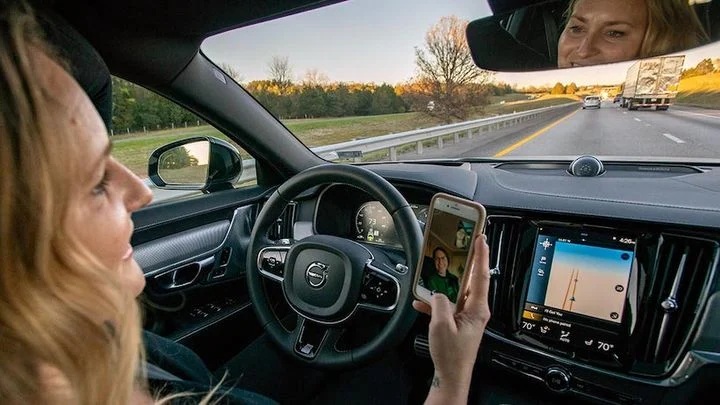Photo: IIHS
Drivers fidget with electronics and take both hands off the wheel more often as they develop trust in automated driver-assistance systems (ADAS).
Drivers fidget with electronics and take both hands off the wheel more often as they develop trust in automated driver-assistance systems (ADAS), new research from the Insurance Institute for Highway Safety (IIHS) and the Massachusetts Institute of Technology’s AgeLab shows.
To investigate how experience with automation affects driver disengagement, the researchers studied the driving behavior of 20 volunteers as they gained familiarity with advanced driver-assistance systems (ADAS), according to IIHS. The study examined how often drivers removed both hands from the steering wheel or took their attention away from the road to do things like use their cellphone or adjust the controls on the vehicle’s console.
One group drove a vehicle equipped with adaptive cruise control (ACC), which automatically keeps the vehicle traveling at a speed chosen by the driver while maintaining a pre-established following distance. Another 10 people drove a vehicle that featured both ACC and pilot assist, which is a partially automated system that combines ACC with lane-centering technology that keeps the vehicle positioned laterally in the travel lane.
After a month, the study found drivers were substantially more likely to let their focus slip or take their hands off the wheel when using automation, and the impact of the vehicles with ACC and pilot assist was more dramatic than that of ACC alone
“Drivers were more than twice as likely to show signs of disengagement after a month of using Pilot Assist compared with the beginning of the study,” said IIHS Senior Research Scientist Ian Reagan, the lead author of the study. “Compared with driving manually, they were more than 12 times as likely to take both hands off the wheel after they’d gotten used to how the lane centering worked.”
Safety features such as pilot assist are not designed to replace the driver. They have trouble negotiating many common road features, so the driver must be in control at all times, the IIHS said.
When it comes to the effect of technology on driver behavior, the new study illustrated differences between stand-alone ACC and the combination of ACC and lane centering.
Drivers in vehicles just equipped with ACC were more likely to look at or pick up a cellphone while using the assistance technology than when driving manually, and that tendency increased substantially as they grew familiar with ACC. On the other hand, increased familiarity did not result in more frequent texting or other kinds of cellphone manipulation known to increase crash risk; drivers using ACC in both vehicles tested weren’t any more likely to remove both hands from the wheel than when driving manually.
These differences could be important in weighing the impact on crash risk from ACC versus partial automation that combines ACC with lane centering, IIHS said. Field tests have suggested that ACC, by controlling speed and following distance, may have safety benefits that go beyond those provided by forward collision warning and automatic emergency braking.
by WT Staff
Source: https://www.automotive-fleet.com
CUT COTS OF THE FLEET WITH OUR AUDIT PROGRAM
The audit is a key tool to know the overall status and provide the analysis, the assessment, the advice, the suggestions and the actions to take in order to cut costs and increase the efficiency and efficacy of the fleet. We propose the following fleet management audit.




